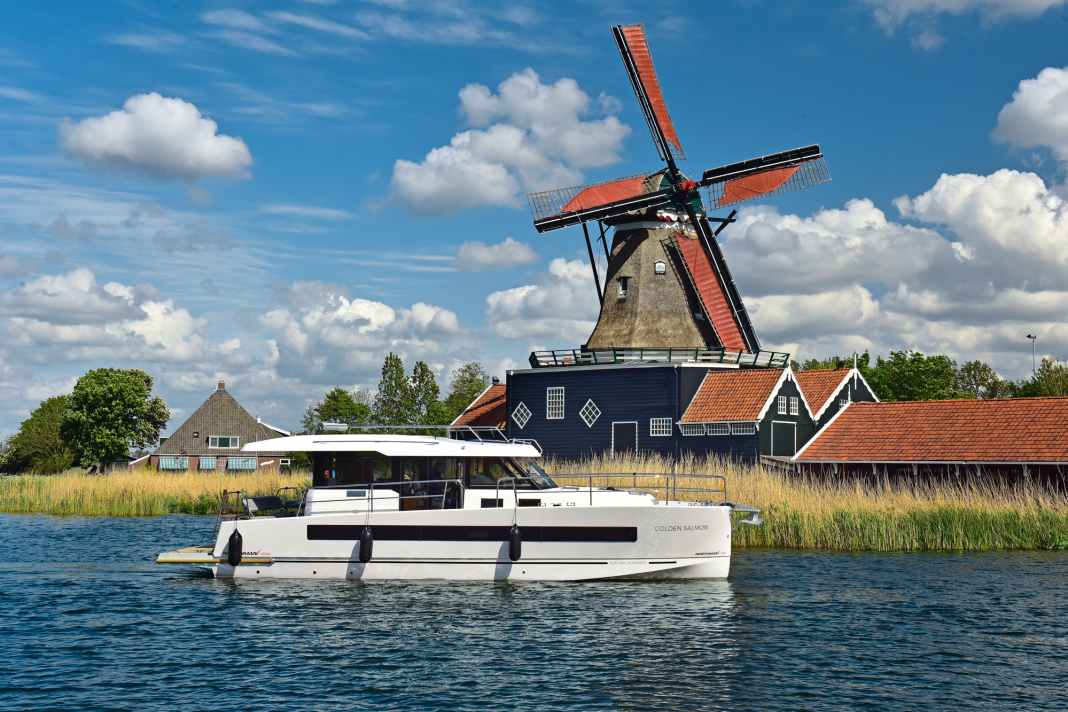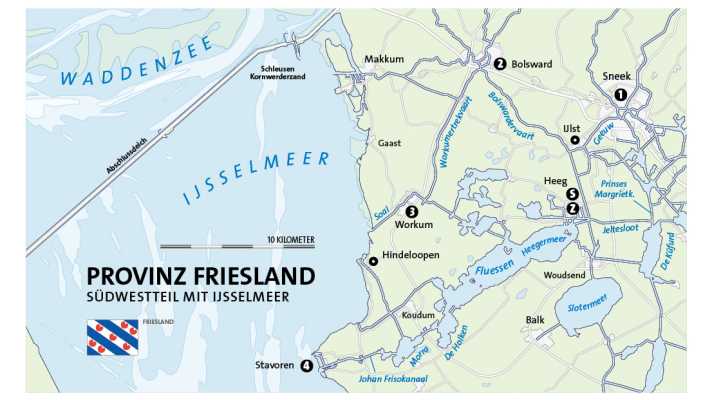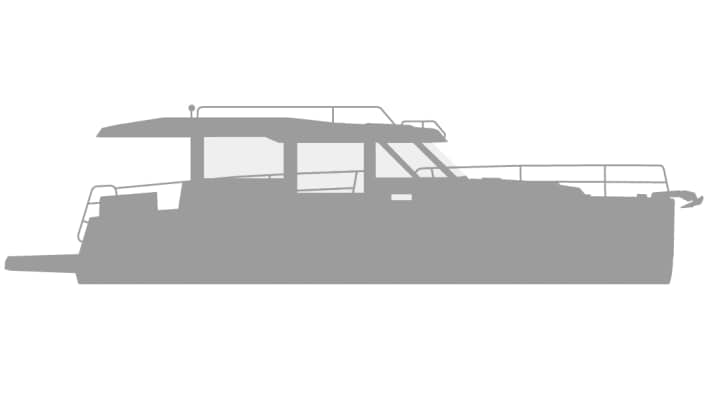





What a feeling! The boat moves sideways out of the box almost silently using the joystick. Skipper Siegrun pushes the throttle forwards. The usual humming of the engine is absent. Only the powerful propulsion and a quiet whirring signalise that our Northman 1200 is still powered by an engine - albeit an electric one. However, our boat is not a small day cruiser, which you now often see motorised like this on inland waterways in Friesland, but a fully-fledged charter yacht with a comfortably equipped living area for six people. Everything here is electric, even the heating, hob and oven. And there is no hidden diesel generator anywhere for emergencies. This electric yacht has zero emissions.
Before casting off, I asked shipyard manager Jurjen Poorting, who developed the Northman, how long you can sail the boat. "As long as you want," is the answer, "it's no different than with a diesel engine." I follow up: "I mean, how long does a battery charge last?"
"It's also similar to a diesel engine. It depends on how many hours and how fast you drive. You have a fuel gauge." He points to the display in the cockpit, which shows a battery charge of 100 per cent.
There are sockets for charging batteries on every jetty in every Frisian town
The white-haired inventor, who radiates incredible calm, asks the counter-question: "How many hours do you realistically ride in an inland area per day?" In my experience, this is better measured in distance travelled: "Twenty to thirty kilometres, I would say."
"Then you'll be able to drive for up to three days," replies Jurjen. "But of course you also have power sockets in every harbour here in Friesland where you can charge the batteries overnight. So there are far more options than there are diesel filling stations."
On the first day of the charter, the sky is dark grey and the province is in constant rain. This is not the weather to go exploring by boat. We do our shopping for the trip and explore the surrounding area by car. We like the old harbour towns in the north of the IJsselmeer. Makkum, Workum, Hindeloopen and Stavoren were seaports on the Waddenzee until the final dyke was built in 1932. But even though there is no longer any significant trade, the spirit of the "Golden Age" still lingers over them.
We leave the harbour labyrinth with the warming sun on our faces
With this in mind, we make our sailing plan: A northern canal route via Sneek to the IJsselmeer, then southwards and back to Heeg via the Frisian lakes. The rain stops on the second day of the charter. As the May sun shines dazzlingly over the water town of Heeg, we untie the mooring lines and leave the Natural Yachts charter base astern. With the warming sun on our faces, we leave the labyrinth of Heeg harbour, turn east into the Jeltesloot and cross motorway 354 on an aqueduct. The Jeltesloot leads at right angles to the Prinses Margrietkanaal, a busy waterway that is part of the Staande Mastroute. This old shipping route, which can be sailed with a standing mast, runs from the Ems via Groningen through the whole of Friesland and flows into the IJsselmeer at Lemmer.
Dutch cargo ships and German sailing boats make for a lot of traffic. But after just 2.5 kilometres, we leave the Staande Mastroute again to the north and head towards Sneek via a side route, the Wâldfeart. The historic centre of Sneek is already within our grasp when we come to a flat bridge. What now? There's a sign on the structure: "Woud-vaartbrug", with a telephone number underneath. I call and someone picks up immediately: "I've already seen you, you'll see me soon."
Country, city, river, lake - Friesland is a paradise for boaters
The bridge keeper arrives by bike, closes the road and lifts the bridge. "Ride straight through to the Lemmerbrug, I'll open it afterwards," he calls from the control stand. We follow the cycling bridge keeper. He also opens the Lemmerbrug and we enter the historic harbour of Sneek. This waterway is called De Kolk. On the starboard side we pass the Waterpoort, the historic water gate from the 17th century. As there is heavy boat traffic in both directions, there is no time to view the historic building from on board. The moorings within sight of the water gate are taken. But 300 metres further west, there are plenty of guest berths on the north bank of the De Geau canal. I look at our fuel gauge: still 80 per cent. Very relaxed, I lay the cable to the nearest socket.
Sneek is a beautiful medieval town which, like all towns in the region, is criss-crossed by navigable canals. Its landmark is the aforementioned twin-towered Waterpoort dating from 1613, which was part of the town fortifications. There are plenty of shops and restaurants along the canals in the city centre.
Every morning, our ship's tanks are 100 per cent full
In the morning, our battery display shows 100 per cent charge again, so the "tanks" are full again. We pay the harbour master 19.30 euros in mooring fees - the standard price for a 12-metre boat in the large municipality of south-west Friesland - point our bow south-west along the De Geau waterway and reach IJlst after three kilometres. The guest harbour Uitkijk lies on the port side at the entrance to the town, where we moor. Houtzaagmolen De Rat, one of the last sawmills powered by a Dutch windmill, operates here.
In addition, the Houtstad werkplaats (Wood Town Museum) with its workshops invites young and old alike. Visitors can learn a lot about the timber industry in IJlst and shipbuilding in particular. The museum houses tools, skates and toys. You can build your own wooden toys in the workshop( www.houtstad-ijlst.nl ).The 730-year-old small town of IJlst has a beautiful centre with old captains' and merchants' houses.
The rest of the route leads through flat, green polder land that has been reclaimed from the Wadden Sea
We head west to get closer to our destination, the IJsselmeer. On leaving the town, we turn north into the Bolswardervaart, which will take us to Bolsward. There is a rotating railway bridge at this turn-off. It is the only bridge during the entire trip where we have to wait a good hour because a suburban train was not on time. The rest of the route takes us through flat, green polder land that has been reclaimed from the Wadden Sea. Bolsward was once a Hanseatic town and was located on the Middelzee, which was pushed back by dykes. The old town centre has been fully preserved and is still completely surrounded by the Stadsgracht canal. We moor in the first row in the Stadsgracht and plug into the nearest socket.
As beautiful as it is here, we are drawn to the sea. After two hours via the Workumervaart, we reach the harbour town of Workum and moor in the centre of the guest harbour on the Diepe Dolde. Workum is a typical Zuiderzee trading town, which became prosperous from the 15th century onwards thanks to overseas trade. There are numerous craft shops, boutiques and restaurants in the old town centre around the market square.
In the morning, we also leave this beautiful little town in the direction of the sea. With full batteries, we pass through the sea lock, then sail another two kilometres on the Soal canal through flat land, before the horizon opens up: the IJsselmeer lies before us. It is so smooth and calm that our electric yacht purrs across it with ease.
The harbour towns on the IJsselmeer used to live from overseas trade
Just three kilometres south of the mouth of the Soal canal lies Hindeloopen, one of the most beautiful places on the east coast of the IJsselmeer. Without having to pass through a lock, we steer into the old harbour and get a fantastic berth right in the centre. With less than a thousand inhabitants, Hindeloopen is one of the smallest towns on the IJsselmeer, but it can look back on almost a thousand years of seafaring tradition. The Old Harbour and the New Harbour, also known as the Sailing Harbour, together take up almost as much space as the rest of the town. In the so-called Golden Age of the Netherlands, the Gouden Eeuw, the shipowners from Hindeloopen maintained over eighty cargo ships that brought goods from the colonies, primarily from the East Indies, and shipped them on to the whole of Europe at a splendid profit. This period of prosperity lasted around one hundred years, peaking after the end of the Thirty Years' War in 1648.
Today, Hindeloopen is an attractive tourist destination. Souvenir shops and pubs line the waterfront. In the low season, the picturesque town is already full of visitors, but you can still find a place anywhere. I'd rather not imagine what it's like in Hindeloopen in July/August.
After a two-hour stopover in Hindeloopen, our batteries are 90 per cent charged, more than enough for our upcoming sea voyage to Stavoren. I would have loved to experience the boat in the wind and swell. But there is a leaden silence over the IJsselmeer, the water is as smooth as a mirror and hundreds of sailors are bobbing on the spot with their sails down. We pass the large sea locks of Stavoren in a crowd of other boats and then turn to port into the old town centre. Here, too, we have no problem finding a berth with a power socket. Stavoren has the liveliest pub scene around the old harbour.
A little melancholy sets in as we motor back inland across the Frisian lakes towards Heeg in the morning. We really enjoyed the pretty towns, as well as our emission-free and quiet electric charter boat, which proved its worth. Friesland in a whisper - a whole new experience.
Service

Cruising stages
S Heeg (charter base) - Sneek: 15 km
- Sneek - IJlst- Bolsward: 15 km
- Bolsward - Workum: 13 km
- Workum - Hindeloopen - Stavoren: 17 km
- Stavoren - Heeg (charter base): 23 km
Z Heeg
Total distance: 83 km
The top 3 in the district
- The harbourUitkijk offers beautiful moorings. Visit the windmill sawmill and Holzstadt museum.
- Workum Located in the centre of the medieval trading town, many artisans, boutiques and quaint pubs.
- Hindeloopen Small town with a great seafaring tradition. The fishermen serve fresh fried fish with chips and beer.
Literature
"Wateralmanak" area manual: Volume 1 with legal texts for the inland waterways of the Netherlands and Belgium, with VHF radio (biennial, 2021/2022 edition; €19.90. ISBN 978-901804-769-6). Volume 2: Operating information on locks, bridges and harbours (annual, 2019 edition; €21.99. ISBN 978-901804-770-2). Order via www.hansenautic.de
Cruising guide "Holland 2. The IJsselmeer and the northern provinces" by Jan Werner. Delius Klasing; 216 p., 75 plans, format: 16.7 x 24.1 cm, paperback; 34.90 euros. ISBN: 978-3-667-10954-5. www.delius-klasing.de

Our boat: Northman 1200 Electric (GRP displacement) - Length: 12.26 m - Width: 3.50 m - Draught: 0.75 m - Berths: 6 (3 double cabins) - WC/shower: 2/2 - Equipment: bow and stern thruster, air conditioning system, heating, induction cooker, solar panels, etc. - All the ship's energy systems are electric. The centrepiece is the lithium iron phosphate batteries with a capacity of 84 kWh. They feed a 48-volt controller that drives an electric motor with an output of 18 kW (24.5 hp). At a speed of 9 km/h, the boat has a range of 13 hours or 115 km. Weekly prices: from € 2080 depending on the season. www.northman.pl
Charter: We took delivery of the Northman 1200 Electric at the charter base of Natural Yachts in Heeg in a very good optical and technical condition. Natural Yachts has the first all-electric charter fleet in the EU. In addition to the Northman 1200 Electric, the smaller Nexus Revo 870 Electric (for 4 people) is also available. From the charter base in Heeg, you can explore the north of the Netherlands with Friesland and the neighbouring provinces. Contact: Natural Yachts, De Opper 6A, 8621 DZ Heeg, Friesland, Netherlands, tel. 0031-515 227 017, en.naturalyachts.com
Nautical information
The precinct: The Frisian inland area is not particularly demanding in nautical terms. However, the closer you get to the high season, the more you have to be prepared for increasing traffic. The IJsselmeer can become very rough in windy conditions and should therefore only be navigated by charter boat if the conditions allow for safe passage. The opening times of bridges and locks can be found (in Dutch) on the website of the province of Friesland ( www.fryslan.frl/brugbediening ) or in the ANWB "Wateralmanak" (Volume 2), which is also on board.
Driving licence: The Northman 1200 Electric can be chartered without a boating licence. Boats up to 15 metres in length that cannot travel faster than 20 km/h are generally licence-free in Holland.

